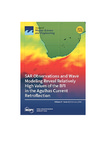Mostrar o rexistro simple do ítem
A Detailed Identification of Classificatory Variables in Ship Accidents: A Spanish Case Study
| dc.contributor.author | Maceiras, Candela | |
| dc.contributor.author | Pérez-Canosa, José M. | |
| dc.contributor.author | Vergara, Diego | |
| dc.contributor.author | Orosa, José A. | |
| dc.date.accessioned | 2021-04-05T13:59:41Z | |
| dc.date.available | 2021-04-05T13:59:41Z | |
| dc.date.issued | 2021 | |
| dc.identifier.citation | Maceiras, C.; Pérez-Canosa, J.M.; Vergara, D.; Orosa, J.A. A Detailed Identification of Classificatory Variables in Ship Accidents: A Spanish Case Study. J. Mar. Sci. Eng. 2021, 9, 192. https://doi.org/10.3390/jmse9020192 | es_ES |
| dc.identifier.issn | 2077-1312 | |
| dc.identifier.uri | http://hdl.handle.net/2183/27655 | |
| dc.description.abstract | [Abstract] The present paper shows an original study of more than 163 ship accidents in Spain showing which of the usually employed variables are related to each type of vessel accident due to the lack of information in this region. To this end, research was carried out based on the Spanish Commission for Investigation of Maritime Accidents and Incidents (CIAIM) reports. Detailed combinatory ANOVA analysis and Bayesian networks results showed a good agreement with studies of other regions but with some particularities per each type of accident analyzed. In particular, ship length was defined as the more relevant variable at the time to differentiate types of accidents. At the same time, both the year of build and the fact that the ship meets the minimum crew members required were excellent variables to model ship accidents. Despite this, the particularities of the Spanish Search and Rescue (SAR) region were defined at the time to identify accidents. In this sense, although variables like visibility and sea conditions were employed in different previous studies as variables related to accidents occurrences, they were the worst variables to define accidents for this region. Finally, different models to relate variables were obtained being the base of deterministic dynamic analysis. Furthermore, to improve the accuracy of the developed work some indications were obtained; revision of CIAIM accidents scales, identification of redundant variables, and the need for an agreement at the time to define the classification limits of each identification variable. | es_ES |
| dc.description.sponsorship | This research was funded by the Sustainability Specialization Campus of the University of A Coruña grant number 6310G49279- 541A- 64900. | es_ES |
| dc.language.iso | eng | es_ES |
| dc.publisher | MDPI | es_ES |
| dc.relation.uri | https://doi.org/10.3390/jmse9020192 | es_ES |
| dc.rights | Atribución 4.0 Internacional (CC BY) | es_ES |
| dc.rights.uri | https://creativecommons.org/licenses/by/4.0/ | * |
| dc.subject | Ship | es_ES |
| dc.subject | Identification | es_ES |
| dc.subject | Accidents | es_ES |
| dc.subject | Modelling | es_ES |
| dc.subject | ANOVA | es_ES |
| dc.subject | Bayesian network | es_ES |
| dc.title | A Detailed Identification of Classificatory Variables in Ship Accidents: A Spanish Case Study | es_ES |
| dc.type | info:eu-repo/semantics/article | es_ES |
| dc.rights.access | info:eu-repo/semantics/openAccess | es_ES |
| UDC.journalTitle | Journal of Marine Science and Engineering | es_ES |
| UDC.volume | 9 | es_ES |
| UDC.issue | 2 | es_ES |
| UDC.startPage | 192 | es_ES |
Ficheiros no ítem
Este ítem aparece na(s) seguinte(s) colección(s)
-
GI-EeP - Artigos [21]






